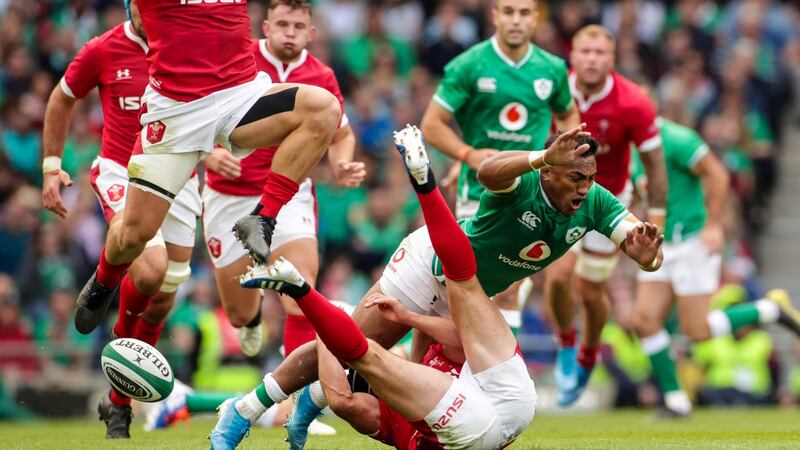Ireland’s true attacking strategy remains shrouded in mystery as the travelling party enters the eye of the storm.
Literally. Typhoon Faxai hit Tokyo on Sunday evening with historic winds of 216km, landslides and flooding predicted. As 20 rugby nations are about to arrive, getting in and out of the central hub for the 2019 World Cup appears problematic with 30 flights already grounded and 50 bullet trains suspended.
For example, the Wallabies flight has been postponed.
September is peak typhoon season in Japan. It should be grand, but if World Rugby’s worst nightmare, a natural disaster, forces some pool matches to be cancelled the results will be recorded as 0-0 draws with both teams awarded two points.
The Ireland squad travels on Wednesday. Hopefully.
Following Saturday’s 19-10 victory over Wales, it now truly feels like a squad. The reserves, or as coaches like to call them ‘The Finishers’, finally gave us a glimpse into Joe Schmidt’s thought process.
The Schmidt playbook has been kept firmly under wraps since victory over Scotland at Murrayfield in February; remember Jacob Stockdale’s try, when he ran an inside line off Johnny Sexton, who took the full force of Allan Dell’s borderline late tackle in order to prise open the defence (Sexton got his season underway by charging headlong into Jake Ball’s 121kg embrace. He may get used to it as similar landslides and flooding of his personal space is guaranteed).
“Ireland went back to what they are traditionally good at,” said Warren Gatland, ever the psychoanalyst. “I think 85 per cent of that second half was off nine, off nine, off nine.”
Ireland can do whatever they want when Bundee Aki and Robbie Henshaw are winning collisions in midfield. They continually thumped into Wales with Tadhg Furlong and James Ryan inching over for second half tries.
This remains the blueprint; Schmidt’s Ireland will seek to pound teams into submission despite overwhelming evidence showing such methods will not be effective against England, South Africa and probably New Zealand.
The offensive strategy cannot and almost certainly will not remain so simplistic.
A noticeable change in direction by the coach appears to be the type of player selected to start and finish. Henshaw, we can see, brings more power to the 13 jersey than Garry Ringrose.
“Garry’s first involvement was making that tackle in behind the advantage line,” said Schmidt of Ringrose replacing an injured Keith Earls on the wing, “and getting up and making the next tackle.”
Ringrose’s role has altered in pre-season from nailed on starting centre to someone the coach believes can fill any number of positions, even outhalf due to his brief exposure at 10 on the Blackrock under-16s, which should never be a reference point for international rugby.
Constant mentions of the 24-year-old’s versatility suggests he’ll wear number 23 should Schmidt settle for the physicality of Aki and Henshaw (“Those two know each other inside out”).
If Ireland are to keep doing what they are “traditionally” good at, multi phase direct rugby, then a heavy toll is guaranteed. That means the Irish bench players will be charged with cancelling out some of the game’s biggest specimens when it all comes down to the last 30 minutes of a World Cup quarter final.
The Springboks bullied and outpaced Japan 41-7 in Saitama on Friday night. The damage was already inflicted when Rassie Erasmus unleashed RG Snyman. At 6 foot 10 inches and 117kg, this 24-year-old monster is taller and heavier than Eben Etzebeth. Such size is why Jean Kleyn and CJ Stander moved to Limerick (tune into the Pro14 to witness the growth spurt of Munster’s other South African, the gigantic prop Kenyon Knox).

Saturday’s bench offered a peek under the covers, a sign of the times, with Rhys Ruddock’s upending tackle on Alun Wyn Jones showing why the blindside got the call ahead of Jordi Murphy. If not for multiple surgeries the 28-year-old would have at least triple his 22 caps.
Power is Andrew Porter landing into a Test match, be it at loose or tighthead prop, and Iain Henderson offers the ideal impact although the incoming Ulster captain will almost certainly start the big games alongside the jewel in Schmidt’s crown, James Ryan.
Kleyn put himself about the park – “He hits big men back,” said Schmidt – in a manner that Devin Toner was, presumably, unable to achieve this summer.
Now, these Irish cruiserweights cannot match the might of Snyman, nor do they possess England’s ability to spring Courtney Lawes and his shuddering tackles late in a game but Schmidt fully intends to select a bench that makes ground-breaking impact.
“The guys who come on are strong but Dave Kilcoyne is dynamic, Sean Cronin is not a huge man but he is dynamic. It’s those sort of players who can change it up one way and then you got a power player like Andrew Porter and Iain Henderson. I thought Rhys Ruddock came on and added a real impact.
“Jack Carty probably didn’t add impact, he’s got very skinny legs, but he is very effective kicking in those legs. He put us down in the corner really effectively and ran the game well.”
Of courses, Joey Carbery remains vital to the cause.
The most contentious selection calls have already began to repay their coach. Luke McGrath’s clever and strong defending surged him past Kieran Marmion while Ruddock and Kleyn look primed.
“I’d like to hope it is a good mix,” Schmidt added. “There was certainly some power.”
That remains the most valuable currency in rugby. Batten down the hatches.












